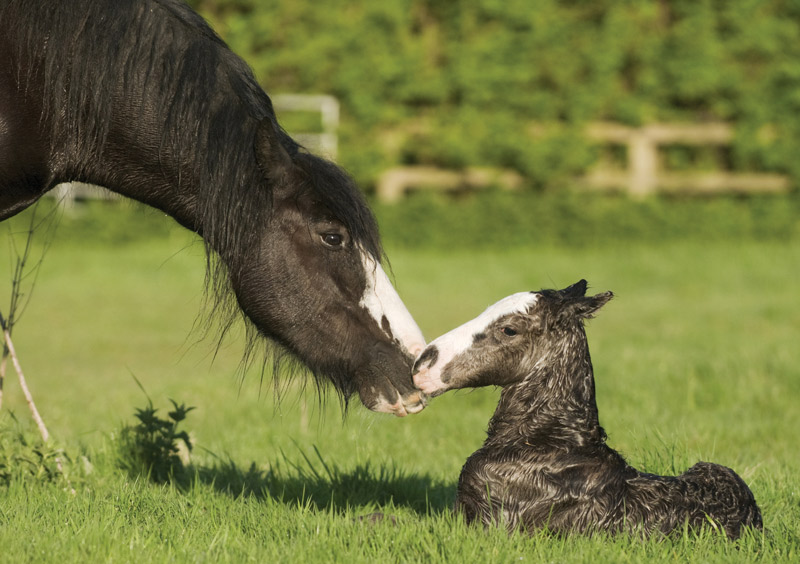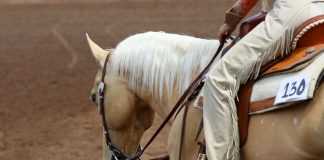
When a vet goes on a call about a difficult horse, the volatile mare takes charge, at least until gravity steps in.
“Doc! Hello, you there?” my client, Greg, bellowed into the phone. “Hey, my mare foaled this morning, and the membranes are still hanging out of her! It’s been over three hours!”
I puffed out my cheeks. It literally never failed. This was the only time this week that I could get my records and billing done, and of course a call had to come in that couldn’t wait.
“Yes, Greg,” I said glumly. “I’m just in town, and I’ll head your way in 10 minutes.”
“Well, what time will you get here?” hollered Greg, who had lived in the area his whole life and knew exactly how long it took to get around.
A Vet’s Dreaded Drive for a Difficult Horse Patient
Sighing, I pulled on my jeans and found a clean polo shirt, then laced up my manure-smelling work boots for the ten-thousandth time, rebelling at the feel of my feet back in tube socks. I just wanted one lousy day to wear something that wasn’t work clothing.
I grumped and fussed to myself as I drove the 25 minutes to Greg’s place. As I pulled up to the farm, I spotted my patient immediately and cringed, realizing just which one it was. Greg cleverly hadn’t warned me that it was Destiny, knowing that I just might have feigned being several hours away. I cursed my rotten, horrid luck.
To say Destiny was hell on wheels was being kind and generous. Really, she was a devil-hearted witch with twin demons for a soul. In my career I’d never met such a dreadful horse, but Greg swore that her babies were the best on the ranch, so he kept breeding her year after year. Normally her foalings were uneventful, but a retained placenta could be life threatening, and I had no choice but to intervene.
I stared warily at her as Greg slipped a halter over her head and led her to me, the tiny foal scrambling along behind her. Destiny made a huge point of twisting her head around to call to her foal, lashing her tail and swinging her hindquarters from side to side, the placenta swinging in an arc behind her. It was tangled in her tail, which she never stopped lashing, and she pinned her ears flat when I approached her, the whites of her eyes in stark relief against her black coat.
“Good girl, Destiny,” I cooed, as I sidled up to her, taking great care not to get between her and the baby. I patted her neck, and she shoved her shoulder hard into me, then tried to bite me.
Greg swatted her. “You quit that, you hag! Doc’s here to help you!”
Getting a Handle on Things
I tried several times to take Destiny’s vitals, but after a hind foot flew past my face and she stomped my toe and almost knocked me down, I gave up and sedated her like I always did, dodging her body as she swung furiously from side to side and spun into me.
And like always, it took 15 minutes and two re-doses before I could safely touch her. At least she was somewhat good for shots, assuming I could get close enough to give them.
The baby, a jet-black filly with a wide blaze, was busily nibbling at my pants, and I stroked her soft neck and curly little mane and gave her back a quick scratch. She closed her eyes in delight and mouthed at the air, so absolutely unlike her mother, who had horns and a tail.
Finally, Destiny’s head dropped, and her lower lip hung down. I quickly wrapped her tail and cleaned her up, then gently threaded a sterile tube into her uterus to lavage (rinse) her with saline until the fluid came out clean.
I then put some careful traction on the retained placenta, but it wasn’t budging. I injected intravenous Banamine, gave her some medicine to help her uterus shrink back down, and started her on antibiotics.
“Let’s put some weight on this placenta, Greg,” I said. “Do you have any plastic water bottles lying around?” I had to be careful with the weight—too much and the uterus could prolapse, but a pint or two would be just perfect.
Greg dug around for a bit and returned with a bottle of fly spray and an unopened bottle of diet soda.
“Sorry Doc, this was all I could find.”
I shrugged and tied the bottles closely to the hanging placenta, and Destiny’s tail immediately started lashing angrily. She came suddenly awake, the bottles swinging behind her, and aimed a kick in my direction, then charged furiously across the field, the baby hot on her heels.
Greg was howling with laughter watching the placenta flying around with the bottles and said that Destiny reminded him of a “Just Married” car. I worried as I watched her run and thought of the pressure on her uterus, but finally she came to a stop and started grazing. The foal was nursing, and I watched them closely for a while before driving off.
Strange Victory
A few hours later, I was with another client—a woman I didn’t know well—when a picture popped up on my phone of the meaty placenta on the ground draped around the soda bottle and the fly spray.
“Oh wonderful,” I said. “That’s so awesome!”
My client craned her neck to look at my phone, then gave me a bewildered look. I smiled and shrugged, figuring that explaining would take more energy than I had at the moment.
I returned to our conversation about her horse’s skin problems and said no more about it, and neither did she. She’s probably still wondering what was so awesome about a mass of bloody tissue, a bottle of fly spray and a diet soda.
This Vet Adventures column about a vet dealing with a difficult horse appeared in the November/December 2020 issue of Horse Illustrated magazine. Click here to subscribe!





